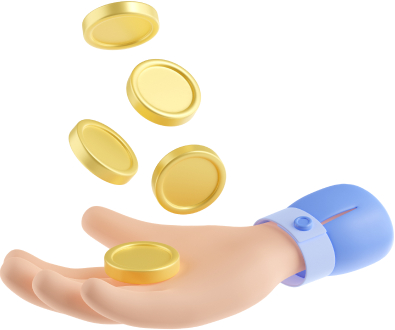Intuitive Payment Calculator Simplifies
Control of Your Loans
Easy-to-use payment calculators show monthly payments, total interest paid, repayment term, and other metrics. Our loan calculators do all the math for you.
When taking out a loan, it’s important to plan how long it will take to pay back and how much you’ll be spending to do so. Our payment calculator shows you how much interest you will pay on a loan based on the interest rate and how long it takes to pay it off. Depending on which payment variables you know or are trying to figure out, you can use either the Fixed Term payment calculator or the Fixed payment calculator. Payment calculators are also called loan calculators.

The fixed-term calculator is when you know the loan amount, how long you will be paying the loan off, and the loan interest rate. This calculator reveals what your monthly payments will be, as well as the total interest you will pay over the term of the loan. You can plug in various numbers to see how different scenarios affect your monthly payments and total interest.

The fixed-payment calculator is used when you know the loan amount, interest rate, and monthly payment. With this calculator, you can see how long it will take to pay off the loan, as well as the total interest you will be paying. You can input different numbers to see how different scenarios play out. For example, if you can negotiate a lower interest rate, you can see your monthly savings versus the original interest rate.
Payment Calculator Input Fields
We’ll next go over how each of the calculators works, and what the variables mean.
Loan amount: The total amount you are borrowing and need to pay back, not including interest. For example, if you get a car loan for $30,000, the loan amount is $30,000. Input this in the Loan Amount field.
Interest rate: The yearly interest rate, in percent, that will apply to the loan amount for as long as the loan is outstanding. For example, if the interest rate on a loan is 6%, then input 6% in the interest rate field.
Loan term: How long you have to repay the loan. A 10-year term, for example, means the loan amount (plus interest) will be repaid over 10 years. If you don’t know this time span, use the Fixed Payment calculator to calculate how long the loan will take to pay back.
Monthly payment: If you know what your monthly payment will be, you can input it into the monthly payment field. For example, if you agreed to pay $300 per month, input $300 into the monthly payment field. If you don’t know the monthly payment amount or want to calculate it, use the Fixed Term calculator to figure it out.
What the Payment Calculator Answers Mean
Depending on which calculator you use, you will get different outputs/answers after you click Calculate. Here’s what each of those payment calculator answers means.
Total Duration in Months: This is how many months it will take to pay back the loan. For example, if it says 48.8 months, then it will take 49 monthly payments to repay the loan, with the final payment (49) being only a partial payment to clean up the remaining balance.
Monthly Payment: The amount of the monthly payment. This is how much you will need to pay each month to repay the loan plus interest within the amount of time specified.
Total Duration in Years: This is how many years it will take to repay the loan. This is the Total Duration in Months divided by 12, since there are 12 months in a year.
Time Required to Clear Debt: How long it will take for the loan, plus interest, to be repaid. This number is expressed in years, so 5.5 would mean 5 years and 6 months.
Total Payment: The amount of the loan plus the interest it will accrue. This is the total amount you are paying to the person or company that you borrowed money from.
Payoff: This shows how long it will take to repay the loan in both years and months.
Total Interest Paid: This amount of interest paid over the entire term of the loan — the Total Payment minus the Loan Amount.
Fixed Term Payment Calculator Example
Here’s an example of how you can use the Fixed Term Payment calculator, assuming you know or can estimate your loan amount, loan term, and interest rate.
Keep in mind you don’t need to know the exact parameters of a loan. You can simply input approximate numbers to get an idea of how different scenarios will affect your monthly loan payments or the total interest you will pay.
Assume you are considering buying a car for $20,000. This is the amount you’ll need to borrow, also called the Loan Amount.
The dealership says you can pay off the loan in up to seven years. You could choose an amount less than this, but that will increase your monthly payments. Let’s assume you decide you will pay off the loan over seven years. That is your Loan Term.
The interest rate is fixed over the life of the loan, and the car dealership is advertising a 4.5% annual percentage rate. This is your Interest Rate.
When we input the $20,000 loan amount, the seven-year loan term, and the 4.5% interest rate into the calculator, you can see how much your monthly car payment will be, as well as the total interest you will pay.
Your monthly payment will be $278, and you will be making that payment for seven years.
The total amount you will be paying is $23,352.27. That’s your initial loan amount, plus interest.
The total interest you will be paying to the car dealership over the seven years is $3,352.27.
Fixed Payment Calculator Example
An example of how to use the Fixed Payment calculator to see how long you will be repaying a loan, assuming you know or can estimate your loan amount, monthly payment, and interest rate.
Assume you are going to borrow $5,000 from a friend and they have agreed to charge you 5% interest per year. You agree to pay them $200 per month. You want to know how long you will be making that monthly payment.
In this scenario, $5,000 is the Loan Amount, the Monthly Payment is $200, and the Interest Rate is 5%.
Plug this data into the payment calculator, click Calculate, and you will see additional loan information appear along the right.
This loan will take 26.5 months (rounded) to repay, which is 2.2 years, or two years and 2.5 months.
You will be paying $200 per month, although there is a fractional payment in your final month of $91.04 (0.45517718654 x $200).
In total, you will be paying your friend $5,291.04. The original loan was $5,000, so you will pay $291.04 in interest.
What factors affect the interest rate you get on a loan?
A key factor in the interest rate you will pay is your credit score. A high credit score, based on your credit history, generally correlates to lower interest rates, while a low credit score equates to paying higher interest. Having excellent credit can save you large amounts of money in interest payments. Income ratios are also a factor. These ratios show how much of your income is going to debt, housing, and other metrics. The more excess capital you have each month, generally the lower risk you are to a lender which generally means lower interest rates.
What can you get a loan for?
Auto loans are one of the most common loan types. A loan on a house is called a mortgage. Student loans are when you borrow money to pay for school. Federal loans are loans provided to you by the government. Farm or equipment loans provide funding for tractors, combines, and other farm tools. Loans are available on almost anything, especially products with high price tags.
What are the different types of loans?
The two main loan types are secured loans and unsecured loans. A secured loan means you borrow money but pledge some asset against the loan, called collateral. If you fail to pay, the lender can take the collateral as payment. In an unsecured loan, if you fail to pay the lender has no specific claim on your assets, but they can refer to the loan to collections.
What companies offer loans?
Banks, credit unions, governments, and car dealerships are common sources of loans or financing. That said, most retail outlets that offer big-ticket purchases offer loans. Credit card companies may also offer loan arrangements, or favorable repayment terms if making large purchases on a credit card (check details with your credit card company).
How can I reduce the amount I need to borrow?
Save up as much capital as possible. The more you can pay yourself, the less you need to borrow. You may also be able to get trade-in value for an existing asset. Getting a credit for your old car, for example, may reduce the amount you need to borrow for purchasing a new car.
Final Thoughts on Payment and Loans Calculators
You can use our loan and payment calculators to calculate what your monthly payments will be on a loan, or how long it will take you to pay back a debt.
Just input a few estimates or figures related to the loan, and click calculate. All the math is done for you.
You may also be interested in our income tax calculator, which shows you how much income tax you will likely be paying. And our investment calculator shows you much your portfolio could grow under different scenarios.
